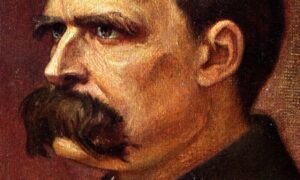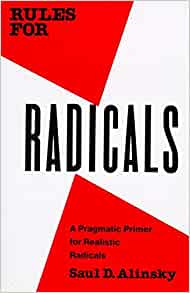The Avant-Garde and the Delusion of American Exceptionalism
The Third Essay on the Limits of Postmodernism after November 2016

In the late nineteenth century, Friedrich Nietzsche asked and answered a question that still haunts the developed world: “‘What is the task of higher education?’ — To turn a man into a machine.” (Twilight of the Idols, trans. R.J. Hollingdale.
Decades after Aldous Huxley and George Orwell published Brave New World and 1984 respectively, Nietzsche’s self-answered question resonates with frightening power. Does higher education turn the person into an object disguised as a subject?
Contemporary education provides unprecedented amounts of quantifiable data. Unfortunately, data is not knowledge, and knowledge is not wisdom. Without critical thinking, without connoisseurship, without the discernment that separates education from ordinary training, the student graduates without the means to separate fact from fiction, reason from irrationality, and culture from kitsch. Such a person knows plenty of data yet finds the world incomprehensible. Again, it pays to revisit Nietzsche: “One has to learn to see, one has to learn to think, one has to learn to speak and write: the end in all three is a noble culture.” (IBID p76.))
Unfortunately, a “noble culture” is no longer a fashionable aspiration, but it should be, if for no other reason than survival. The lessons of twentieth-century totalitarianism should serve as evidence of the suffering, destruction, and death that emerge from the failure to see, think, speak, and write. Art is essential to a “noble culture.”
As Albert Camus wrote: “It is not surprising that artists and intellectuals should have been the first victims of modern tyrannies, whether of the Right or of the Left. Tyrants know there is in the work of art an emancipatory force, which is mysterious only to those who do not revere it.” (The Artist and His time: Create Dangerously, in Resistance, Rebellion, and Death, trans. Justin O’Brien)
Since it is disturbing to think that modern liberal democracies could fear the arts, is there any evidence that the arts are in danger? In the United States alone, the arts appear to be thriving. There have never been more galleries, artists’ spaces, blockbuster shows, art fairs, and assorted arts gatherings, including literary events. Indeed, the art scene seems vibrant and healthy. Regrettably, it is often a delusion. A closer look at the work and conversations with many of the artists soon reveal a profound lack of canonical understanding, aesthetic depth, or genuine vocation. Behind the façade of postmodern erudition, replete with its incomprehensible jargon, lie ignorance, confusion, solipsism, and a mercenary mix of social consciousness and naked careerism. The contradictions become clear when an exchange with a star graduate student reveals not only ignorance of basic art history and theory but hostility to the suggestion that they may be important and useful. When the university itself supports the student’s anti-intellectualism as an expression of “relevance,” it becomes clear that the institution is invested in something other than the arts or even education. Only then does Camus’ dark observation assume a democratic guise. Perhaps the “emancipatory force” of the arts threatens free societies as well as authoritarian regimes.
Within the modern university and its art departments, the will to ignorance does not necessarily result from illiteracy, a lack of information, or an absence of technical knowledge. After all, even the most educated are doomed to ignorance. No one can know or master everything.
The problem, therefore, is not the ability to acquire information but the lack of understanding that should, in turn, lead to an endless series of open questions. For the arts and humanities, definitive answers risk becoming ideologies that can degenerate into dogma. in that sense, the will to ignorance is a quest for certainty. Artists, in particular, must distrust the allure of certainty: they must keep their questions alive without losing their historical and cultural perspectives. Only an understanding of historical precedent can mitigate the arrogance of contemporary relevance. A willful dismissal of the past breeds ignorance and false originality.
Under the postmodernist umbrella, a contradictory mix of pluralistic relativism and absolutist intransigence has come to dominate fine arts graduate programs. Still, it would be unfair and historically untenable to blame postmodern theory alone for the current situation. The debacle is postmodern only in the sense that the theory coincided with social, political, and economic changes that led to the appropriation of ideas that could be applied to the refinement of a more efficient, controlling, and, above all, profitable institution.
It is important to remember that many of the older administrators in today’s art schools emerged from the counterculture of the 1960s and 1970s to become stalwarts of the system they once pretended to loathe. As bourgeois veterans of the era, they grasped that the revolutionary rhetoric of their youth could be packaged, branded, and sold as an ethos of personal identity and freedom. Furthermore, they realized that the observations of social activists such as Saul Alinsky could be adapted to capitalist ends. They also understood that Frankfurt School critical theory had enormous exchange value. Marx himself could be commodified along with Che Guevara and Patrice Lumumba. The quest for social justice and the liberation of the marginalized could be offered as consumable pedagogical products.
Victimhood and revolution became hot items along with the psychotropic medications that by the 1990s were proving their worth as tools for the control of children and would allow educators to keep students under a tight leash. Eventually, the arrival of smartphones and social media would combine with the Patriot Act and the expanded powers of Title IX to produce an amalgam of Foucault’s panoptical society, Huxley’s soma-fueled dystopia, and Orwell’s nightmare of “groupthink” and “newspeak.”
 Within academia, what Saul Alinsky had criticized as the society of “consensus”(Rules for Radicals: A Pragmatic Primer for Realistic Radicals), had replaced the “conflict” he described as “the essential core of a free and open society.” (IBID p 62)
Within academia, what Saul Alinsky had criticized as the society of “consensus”(Rules for Radicals: A Pragmatic Primer for Realistic Radicals), had replaced the “conflict” he described as “the essential core of a free and open society.” (IBID p 62)
Thus the university was able to consolidate power and maximize profits while projecting a progressive image. The “free and open society” gave way to an environment of fear, suspicion, and self-policing where the exercise of academic freedom could result in expulsion for faculty and a pariah status for students who questioned the dogma of their peers. Repressive speech codes, the denigration of Enlightenment values, and the celebration and elevation of personal dysfunction granted the institution a level of authority and profitability it never enjoyed when it was openly traditional. Power and greed could now hide behind the pursuit of social justice while tuition and administrative salaries rose to unprecedented levels. Only the sports coach, that beloved paragon of collegiate parasitism, could challenge the nearly one million-dollar salary that some university presidents enjoy.
For the arts, the results were nothing less than a validation of mediocrity. Aesthetics surrendered to identity politics as the primary focus of art. Propaganda triumphed as the dominant genre in graduate programs where cookie-cutter installations and ever-duller performances un-selfconsciously mocked the notion of an avant-garde.
A century after Duchamp’s first readymades and the Dadaist revolt against a suicidal civilization, what passes for art is as formulaic as it was in the days of the l’académie des beaux-arts, but with a crucial difference: more often than not, it lacks the technical, art historical, and theoretical rigor necessary to surpass its limitations.
Can postmodernism be held responsible—does it have the ideological cohesion to account for the debacle? In the same way that an entrepreneur studies Marx in order to be a better capitalist, a good administrator studies the postmodern analysis of power in order to exercise it more efficiently. Consequently, it cannot be said that postmodernism ruined the arts. Instead, its better thinkers unwittingly provided the analytical tools necessary for the manipulation of students, parents, consumers, and voters across the ideological spectrum. Michel Foucault never intended his understanding of the panopticon to be used for its expansion, but it nonetheless aided in the creation of an increasingly surveillance driven society.
Jean-François Lyotard never meant for his concept of the micro-narrative to be an invalidation of history and the canon, yet it still served to justify the erasure of historical memories for the sake of mass control.
Tragically, the postmodern questioning of modernist certainty became a self-fulfilling prophecy about a world in which uncertainty would serve the interests of corporate and political entities devoid of self-doubt. Art schools could not escape the trap. They eventually became the tomb of the avant-garde: a place where the illusion of progress killed and buried the remnants of the rebellious and inquisitive spirit that defined modernism. Systematically denied the means to see, think, speak, and write, the art student graduates as a neurotic and ignorant machine trained to parrot radical slogans for a revolution that will never be.
Under the circumstances, it is fitting to revisit Camus: “The first concern of any dictatorship is, consequently, to subjugate both labor and culture. In fact, both must be gagged or else, as tyrants are well aware, sooner or later one will speak up for the other.”(IBID p95)
This leads to a troubling question: at a time when “labor and culture” are both in doubt, who will speak for whom?
Jorge Miguel Benitez Essay 2 Essay 1
Jorge Miguel Benitez holds a master of fine arts degree in painting from Virginia Commonwealth University where he currently teaches drawing, art theory and the history of visual communications. He is a native of Cuba who spent his formative years in Belgium. His European childhood, along with his family’s experience as Cuban expatriates, gave him a historical outlook that permeates his work and scholarly research. His theoretical interests also derive from an earlier career in advertising as well as his fluency in French and Spanish. He currently participates in regional and international exhibitions and writes on subjects ranging from the Cuban Revolution to postmodernism. His work is represented in corporate collections and the Virginia Museum of Fine Arts.
Volume 31 number 5 May / June 2017 pp 11-13
